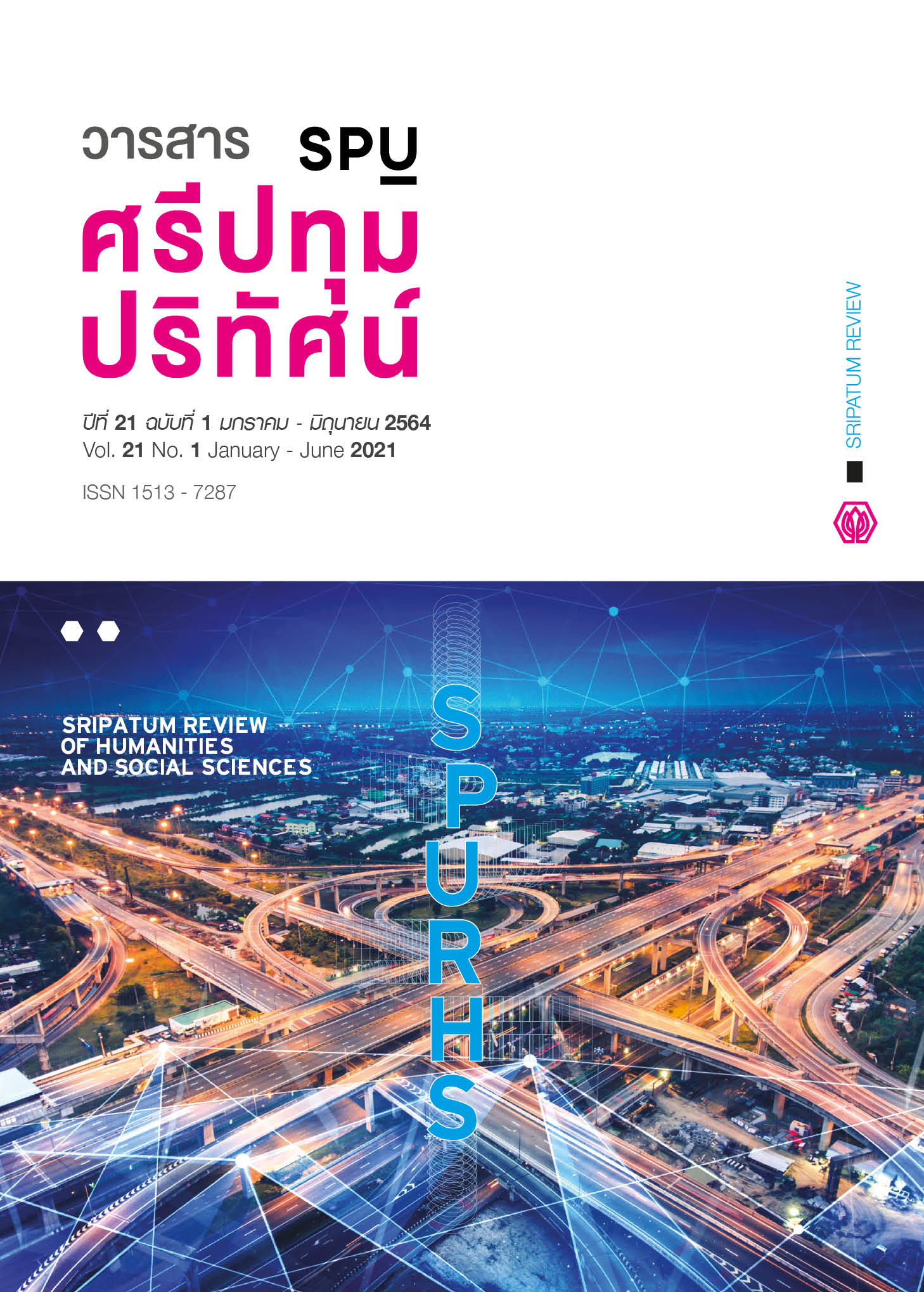The Relationship between the Learning Styles and Mathematics Growth Scores for the seventh Grade Students of Patumwan Demonstration School Srinakharinwirot University
Main Article Content
Abstract
The purposes of this research were (1) to study the learning styles of the 7th grade students, (2) to investigate the relationship between the learning styles and the levels of mathematics achievement scores, and (3) to analyze the interaction between the learning styles, gender, and mathematics growth scores. The population comprised 348 seventh grade students of Patumwan Demonstration School, Srinakharinwirot University in the academic year 2018, obtained by purposive selection technique. The employed research tools were (1) a VARK learning styles questionnaire, developed based on the concept of Fleming (2012); and (2) a mathematics learning achievement test. Data were analyzed using descriptive statistics and inferential statistics including chi-square test and two-way repeated measure ANOVA. The research findings were as follows: (1) the number of seventh grade students of Patumwan Demonstration School, Srinakharinwirot University who had the single modal learning style preference was 49.71%; the number of those who had the bi-modal learning style was 38.79%; the number of those who had the tri-modal learning style preference was 9.77%; and the number of those who had all four modal learning styles was 1.72%; (2) there was no relationship between the learning styles and the levels of mathematics achievement scores ( =1.773, p=.389); and (3) there was no interaction between the learning styles, gender, and mathematics growth scores of the 7th grade students (F = .524, p = .675).
Article Details
1. กองบรรณาธิการสงวนสิทธิ์ในการพิจารณาและตัดสินการตีพิมพ์บทความในวารสาร
2. บทความทุกเรื่องจะได้รับการตรวจสอบทางวิชาการโดยผู้ทรงคุณวุฒิ แต่ข้อความและเนื้อหาในบทความที่ตีพิมพ์เป็นความรับผิดชอบของผู้เขียนแต่เพียงผู้เดียว มิใช่ความคิดเห็นและความรับผิดชอบของมหาวิทยาลัยศรีปทุม
3. การคัดลอกอ้างอิงต้องดำเนินการตามการปฏิบัติในหมู่นักวิชาการโดยทั่วไป และสอดคล้องกับกฎหมายที่เกี่ยวข้อง
References
Anastasi, A. (1982). Psychological Testing 5th ed. New York: Macmillan.
Bloom, B. S. (1976). Human characteristics and school learning. New York: McGraw-Hill.
Caldwell, G. P., and Ginthier, D. W. (1996). Differences in Learning Styles of Low Socioeconomic Status for Low and High. Education, 117(1), 141-147.
Davis, K. J. (1991). Educational implications of field dependence. In S. Wapner, and J. Demick, Field dependence-independence: cognitive style across the life span (pp. 146-176). Hillsdale: Lawrence Erlbaum Associates.
Dunn, R. (1983). Learning Style and its Relation to Exceptionality at Both Ends of the Spectrum. Exceptional Children, 49(6), 496-506.
Dunn, R. S., Dunn, K. J., and Price, G. E. (1996). Productivity Environmental Preference Survey. lawrence: Price Systems.
Felder, R. M., and Brent, R. (2005). Understanding Student Differences. Journal of Engineering Education, 94(1), 57-72.
Fleming, N. D. (2001). Teaching and Learning Styles VARK Strategies. [Online]. Retrieved March 20, 2018, from: http://vark-learn.com.
Fleming, N. D. (2012). Teaching and Learning Styles VARK Strategies. Lyttelton: by the Author.
Fleming, N. D., and Bonwell, C. C. (2018). VARK a guide to learning preferences. Retrieved March 20, 2018, from The VARK Questionnaire: http://vark-learn.com/
Ikechukwu, O. K. (2017). Learning Styles as Predictors of Students’ Academic Achievement in Rivers State. International Journal of Novel Research in Education and Learning, 4(6), 60-67.
Intachai, A. (2013). Factors Related to Mathematics Learning Achievement of Engineers Students at Rajamangala University of Technology Lanna Chiangmai. Chiang Mai: RMUTL. (in Thai)
Intaraprasert, P. (2010). Factors Affecting Learning Achievement of Matthayomsuksa 6 student in Satreeprasertsin School under The Office of Trat Educational Service Area. Chonburi: Burapha University. (in Thai)
IPST. (2018). PISA 2015 Results Science Reading and Mathematics: Excellence and Equity in Education. Bangkok: IPST. (in Thai)
Jahanbakhsh, R. (2012). Learning styles and academic achievement: a case study of Iranian high school girls’ students. Social and Behavioral Sciences, 51, 1030-1034.
Jayanama, B. (2017). Relationship between learning styles and academic achievement of low and high proficiency students in Foundation English of Srinakharinwirot. Scholar: Human Sciences, 9(2), 18-30.
Jonassen, D. H., and Grabowski, B. L. (1993). Handbook of Individual Differences, Learning, and Instruction. Mahwah: Lawrence Erlbaum Associates.
Adnan, M., Abdullah, M.F.N.L., Ahmad, C.N.C, Puteh, M., Zawawi, Y.Z. and Maat, S.T. (2013). Learning Style and Mathematics Achievement among. World Applied Sciences High Performance School Students, 28(3), 392-399.
Ministry of Education. (2008). Basic Education Core Curriculum. Bangkok, Thailand: Basic Education Commission. (in Thai)
Munir, N., Ahmad, N., and Hussain, S. (2018, July-Sept). Relationship of learning styles and academic performance of secondary school. Rawal Medical Journal, 43(3), 421-424.
Naimie, Z., Siraj, S., Chua , Y., Shagholi, R., and Abuzaid, R. A. (2010). Do you think your match is made in heaven? Teaching styles/learning styles match and mismatch revisited. Procedia Social and Behavioral Sciences, 2, 349-353.
NIETS. (2017). Ordinary National Educational Test 2012-2015 Results. [Online]. Retrieved August 23, 2017, from The National Institute of Educational Testing Service (Public Organization): http://www.niets.or.th (in Thai)
Nuzhat, A., Salem, R. O., Hamdan, N. A., and Ashour, N. (2013). Gender differences in learning styles and academic performance of medical students in Saudi Arabia. Medical Teacher, 35(S1), 78-82.
ONEC. (2013). National Education Act B.E.2542 (1999) and Amendments (Third National Education Act B.E.2553 (2010)) . Bangkok: The Books Publishing. (in Thai)
Penge, S., Tekavčič, M., and Dimovski, V. (2008). Meta-Analysis and Empirical Research of Learning Style TheoriesIn Higher Education: The Case of Slovenia. Journal of College Teaching and Learning, 5(11), 1-22.
Pritchard, A. (2009). Ways of Learning 2 ed. New York: Routledge.
Rogosa, D., and Saner, H. (1995). Longitudinal Data Analysis Examples with Random Coefficient Models. Journal of Educational and Behavioral Statistics, 20(2), 149-170.
Rundle, S. M. (2006). An introduction to Building Excellence Survey. Danbury: Performance Concepts International.
Seifert, H. E. (2016). Gender Differences, Learning Styles, and Participation in Higher Mathematics. College of Education. Minneapolis: Walden University.
Shahrill, M., Mahalle, S., Matzin, R., Sheikh Hamid, M., and Mundia, L. (2013). A Comparison of Learning Styles and Study Strategies used by Low and High Math Achieving Brunei Secondary School Students: Implications for Teaching. International Education Studies, 6(10), 39-46.
Tanyarattanasrisakul, M. (2014). The effect of learning provision by SSCSE Model on problem solving skills and mathematics achievement application of statistics for Mathayomsuksa 6 students. Bangkok: Silpakorn University. (in Thai)
Wiratchai, N. (1999). LISREL: Statistical Methods used in Research. 3th ed.. Bangkok: Chulalongkorn University Publishing. (in Thai)


